Large Roll Vortices Exhibited by Post-Tropical Cyclone Sandy during Landfall
Abstract
1. Introduction
2. Data and Model Simulation
2.1. Doppler Radar Observations
2.2. WRF Simulation
2.3. Linearized Roll Vortex Model
3. Evidence of Rolls in Sandy
3.1. Radar Observations
3.2. WRF Simulation
4. Roll Size and Formation Mechanism
4.1. Horizontal Wavelength
4.2. Roll Structure and Formation Mechanism
4.3. Mean Environment
5. Impact of Rolls on Surface Wind Speed
6. Summary
Author Contributions
Funding
Institutional Review Board Statement
Informed Consent Statement
Data Availability Statement
Acknowledgments
Conflicts of Interest
References
- Greenberg, C.H.; McNab, W. Forest disturbance in hurricane-related downbursts in the Appalachian mountains of North Carolina. For. Ecol. Manag. 1998, 104, 179–191. [Google Scholar] [CrossRef]
- Wurman, J.; Winslow, J. Intense Sub-Kilometer-Scale Boundary Layer Rolls Observed in Hurricane Fran. Science 1998, 280, 555–557. [Google Scholar] [CrossRef] [PubMed]
- Ellis, R.; Businger, S. Helical circulations in the typhoon boundary layer. J. Geophys. Res. Space Phys. 2010, 115, 06205. [Google Scholar] [CrossRef]
- Kuettner, J. The Band Structure of the Atmosphere. Tellus 1959, 11, 267–294. [Google Scholar] [CrossRef]
- Walter, B.A.; Overland, J.E. Observations of Longitudinal Rolls in a Near Neutral Atmosphere. Mon. Weather Rev. 1984, 112, 200–208. [Google Scholar] [CrossRef][Green Version]
- Kelly, R.D. Horizontal Roll and Boundary-Layer Interrelationships Observed over Lake Michigan. J. Atmos. Sci. 1984, 41, 1816–1826. [Google Scholar] [CrossRef]
- Christian, T.W.; Wakimoto, R.M. The Relationship between Radar Reflectivities and Clouds Associated with Horizontal Roll Convection on 8 August 1982. Mon. Weather Rev. 1989, 117, 1530–1544. [Google Scholar] [CrossRef][Green Version]
- Etling, D.; Brown, R.A. Roll vortices in the planetary boundary layer: A review. Bound.-Layer Meteorol. 1993, 65, 215–248. [Google Scholar] [CrossRef]
- Young, G.S.; Kristovich, D.A.R.; Hjelmfelt, M.R.; Foster, R.C. Rolls, Streets, Waves, and More: A Review of Quasi-Two-Dimensional Structures in the Atmospheric Boundary Layer. Bull. Am. Meteorol. Soc. 2002, 83, 997–1001. [Google Scholar] [CrossRef]
- Gall, R.; Tuttle, J.; Hildebrand, P. Small-scale spiral bands observed in Hurricanes Andrew, Hugo, and Erin. Mon. Wea. Rev. 1998, 126, 1749–1766. [Google Scholar] [CrossRef]
- Nolan, D.S. Instabilities in hurricane-like boundary layers. Dyn. Atmos. Oceans 2005, 40, 209–236. [Google Scholar] [CrossRef]
- Lorsolo, S.; Schroeder, J.L.; Dodge, P.; Marks, F. An Observational Study of Hurricane Boundary Layer Small-Scale Coherent Structures. Mon. Weather Rev. 2008, 136, 2871–2893. [Google Scholar] [CrossRef]
- Zhang, J.A.; Katsaros, K.B.; Black, P.G.; Lehner, S.; French, J.R.; Drennan, W.M. Effects of Roll Vortices on Turbulent Fluxes in the Hurricane Boundary Layer. Boundary-Layer Meteorol. 2008, 128, 173–189. [Google Scholar] [CrossRef]
- Foster, R. Signature of Large Aspect Ratio Roll Vortices in Synthetic Aperture Radar Images of Tropical Cyclones. Oceanography 2013, 26, 58–67. [Google Scholar] [CrossRef]
- Ito, J.; Oizumi, T.; Niino, H. Near-surface coherent structures explored by large eddy simulation of entire tropical cyclones. Sci. Rep. 2017, 7, 3798. [Google Scholar] [CrossRef]
- Zhu, P. Simulation and parameterization of the turbulent transport in the hurricane boundary layer by large eddies. J. Geophys. Res. Space Phys. 2008, 113, D17. [Google Scholar] [CrossRef]
- Nakanishi, M.; Niino, H. Large-Eddy Simulation of Roll Vortices in a Hurricane Boundary Layer. J. Atmos. Sci. 2012, 69, 3558–3575. [Google Scholar] [CrossRef]
- Green, B.W.; Zhang, F. Idealized Large-Eddy Simulations of a Tropical Cyclone–like Boundary Layer. J. Atmos. Sci. 2015, 72, 1743–1764. [Google Scholar] [CrossRef]
- Pantillon, F.; Adler, B.; Corsmeier, U.; Knippertz, P.; Wieser, A.; Hansen, A. Formation of Wind Gusts in an Extratropical Cyclone in Light of Doppler Lidar Observations and Large-Eddy Simulations. Mon. Weather Rev. 2019, 148, 353–375. [Google Scholar] [CrossRef]
- Mourad, P.D.; Brown, R.A. Multiscale Large Eddy States in Weakly Stratified Planetary Boundary Layers. J. Atmos. Sci. 1990, 47, 414–438. [Google Scholar] [CrossRef]
- Foster, R.C. Why Rolls are Prevalent in the Hurricane Boundary Layer. J. Atmos. Sci. 2005, 62, 2647–2661. [Google Scholar] [CrossRef]
- Blake, E.S.; Kimberlain, T.B.; Berg, R.J.; Cangialosi, J.P.; Beven, J.L., III. Tropical Cyclone Report: Hurricane Sandy; Tech. Rep. AL182012; NOAA/National Hurricane Center: Miami, FL, USA, 2013; 157p.
- NOAA National Weather Service (NWS) Radar Operations Center. NOAA Next Generation Radar (NEXRAD) Level 2 Base Data. Products N0U, N0Q. 1991. Available online: https://www.ncei.noaa.gov/access/metadata/landing-page/bin/iso?id=gov.noaa.ncdc:C00345 (accessed on 18 June 2019).
- Morrison, I.; Businger, S.; Marks, F.; Dodge, P.; Businger, J.A. An Observational Case for the Prevalence of Roll Vortices in the Hurricane Boundary Layer. J. Atmos. Sci. 2005, 62, 2662–2673. [Google Scholar] [CrossRef]
- Chrisman, J.N.; Smith, S.D. Enhanced velocity azimuth display wind profile (EVWP) function. In Proceedings of the 34th Conference on Radar Meteorology, Williamsburg, VA, USA, 5–9 October 2009. [Google Scholar]
- Wyngaard, J.C. Toward numerical modeling in the “terra incognita”. J. Atmos. Sci. 2004, 61, 1816–1826. [Google Scholar] [CrossRef]
- Haupt, S.E.; Kosovic, B.; Shaw, W.; Berg, L.K.; Churchfield, M.; Cline, J.; Draxl, C.; Ennis, B.; Koo, E.; Kotamarthi, R.; et al. On Bridging A Modeling Scale Gap: Mesoscale to Microscale Coupling for Wind Energy. Bull. Am. Meteorol. Soc. 2019, 100, 2533–2550. [Google Scholar] [CrossRef]
- LeMone, M.A.; Angevine, W.M.; Bretherton, C.S.; Chen, F.; Dudhia, J.; Fedorovich, E.; Katsaros, K.B.; Lenschow, D.H.; Mahrt, L.; Patton, E.G.; et al. 100 Years of Progress in Boundary Layer Meteorology. Meteorol. Monogr. 2019, 59, 9.1–9.85. [Google Scholar] [CrossRef]
- Johnsen, P.; Straka, M.; Shapiro, M.; Norton, A.; Galarneau, T. Petascale WRF simulation of Hurricane Sandy: Deployment of NCSA’s Cray XE6 Blue Waters. In Proceedings of the SC13: International Conference for High Performance Computing, Networking, Storage and Analysis, Denver, CO, USA, 17–21 November 2013; IEEE: New York, NY, USA, 2014. [Google Scholar]
- Hong, S.-Y.; Noh, Y.; Dudhia, J. A New Vertical Diffusion Package with an Explicit Treatment of Entrainment Processes. Mon. Weather Rev. 2006, 134, 2318–2341. [Google Scholar] [CrossRef]
- Skamarock, W.C.; Klemp, J.B.; Dudhia, J.; Gill, D.O.; Barker, D.M.; Wang, W.; Powers, J.G. A Description of the Advanced Research WRF Version 3; NCAR Technical Note NCAR/TN-475+STR; National Center for Atmospheric Research: Boulder, CO, USA, 2008. [Google Scholar]
- Zhang, D.; Anthes, R.A. A High-Resolution Model of the Planetary Boundary Layer—Sensitivity Tests and Comparisons with SESAME-79 Data. J. Appl. Meteorol. 1982, 21, 1594–1609. [Google Scholar] [CrossRef]
- Wu, L.; Liu, Q.; Li, Y. Tornado-scale vortices in the tropical cyclone boundary layer: Numerical simulation with the WRF–LES framework. Atmos. Chem. Phys. Discuss. 2019, 19, 2477–2487. [Google Scholar] [CrossRef]
- Hong, S.Y.; Lim, J.O.J. The WRF single-moment 6-class microphysics scheme (WSM6). J. Korean Meteor. Soc. 2006, 42, 129–151. [Google Scholar]
- Schiavone, J.A.; Johnsen, P.J. High resolution WRF simulation of Hurricane Sandy (2012) wind during landfall. Zenodo 2020. [Google Scholar] [CrossRef]
- Gao, K.; Ginis, I. On the Generation of Roll Vortices due to the Inflection Point Instability of the Hurricane Boundary Layer Flow. J. Atmos. Sci. 2014, 71, 4292–4307. [Google Scholar] [CrossRef]
- Simpson, R.H. The hurricane disaster potential scale. Weatherwise 1974, 27, 169–186. [Google Scholar]
- Wang, S.; Jiang, Q. Impact of vertical wind shear on roll structure in idealized hurricane boundary layers. Atmos. Chem. Phys. Discuss. 2017, 17, 3507–3524. [Google Scholar] [CrossRef]
- Gao, K.; Ginis, I. On the Characteristics of Linear-Phase Roll Vortices under a Moving Hurricane Boundary Layer. J. Atmos. Sci. 2018, 75, 2589–2598. [Google Scholar] [CrossRef]
- NOAA National Climatic Data Center. 1-Minute ASOS Data. 2019. Available online: ftp://ftp.ncdc.noaa.gov/pub/data/asos-onemin/ (accessed on 12 May 2018).

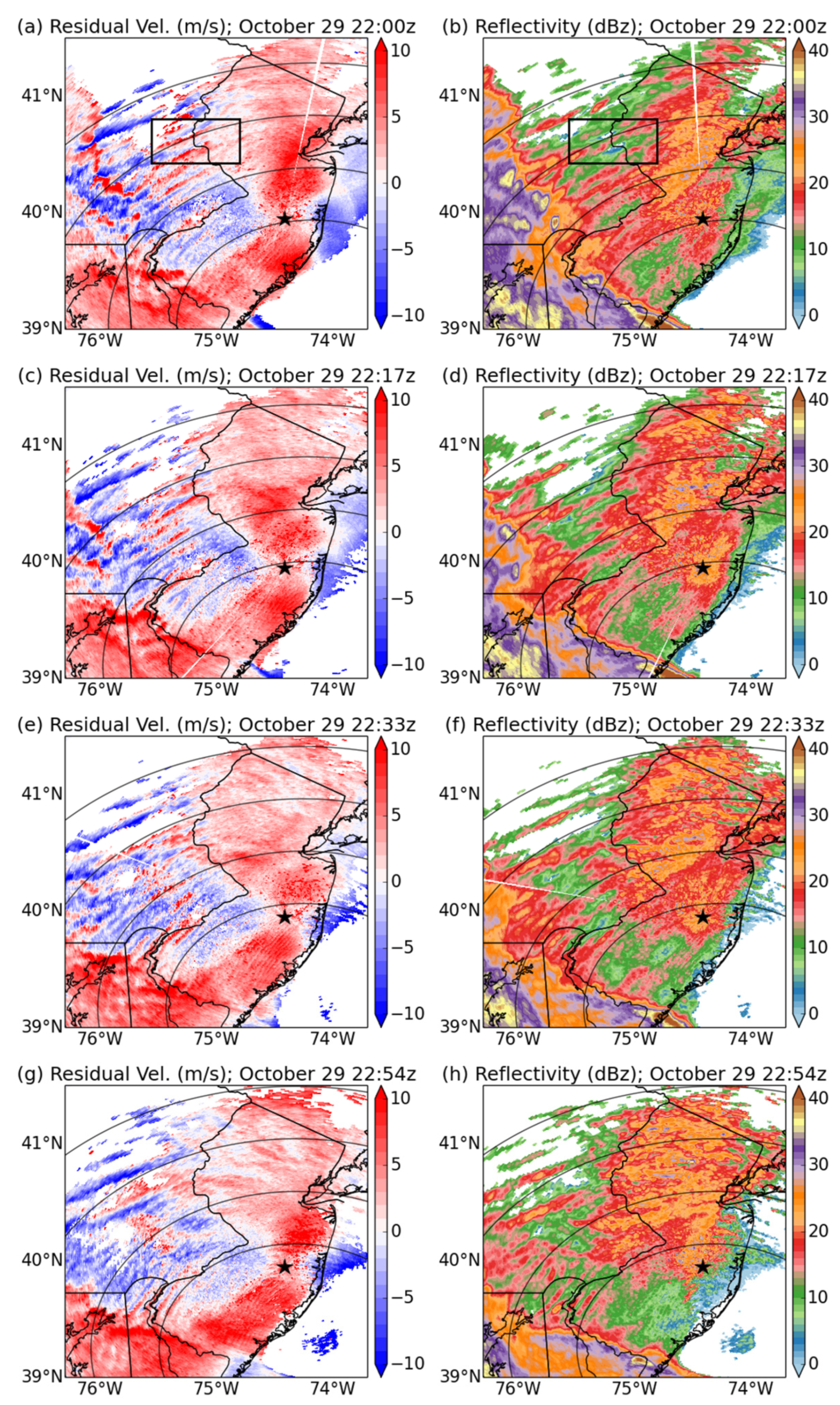
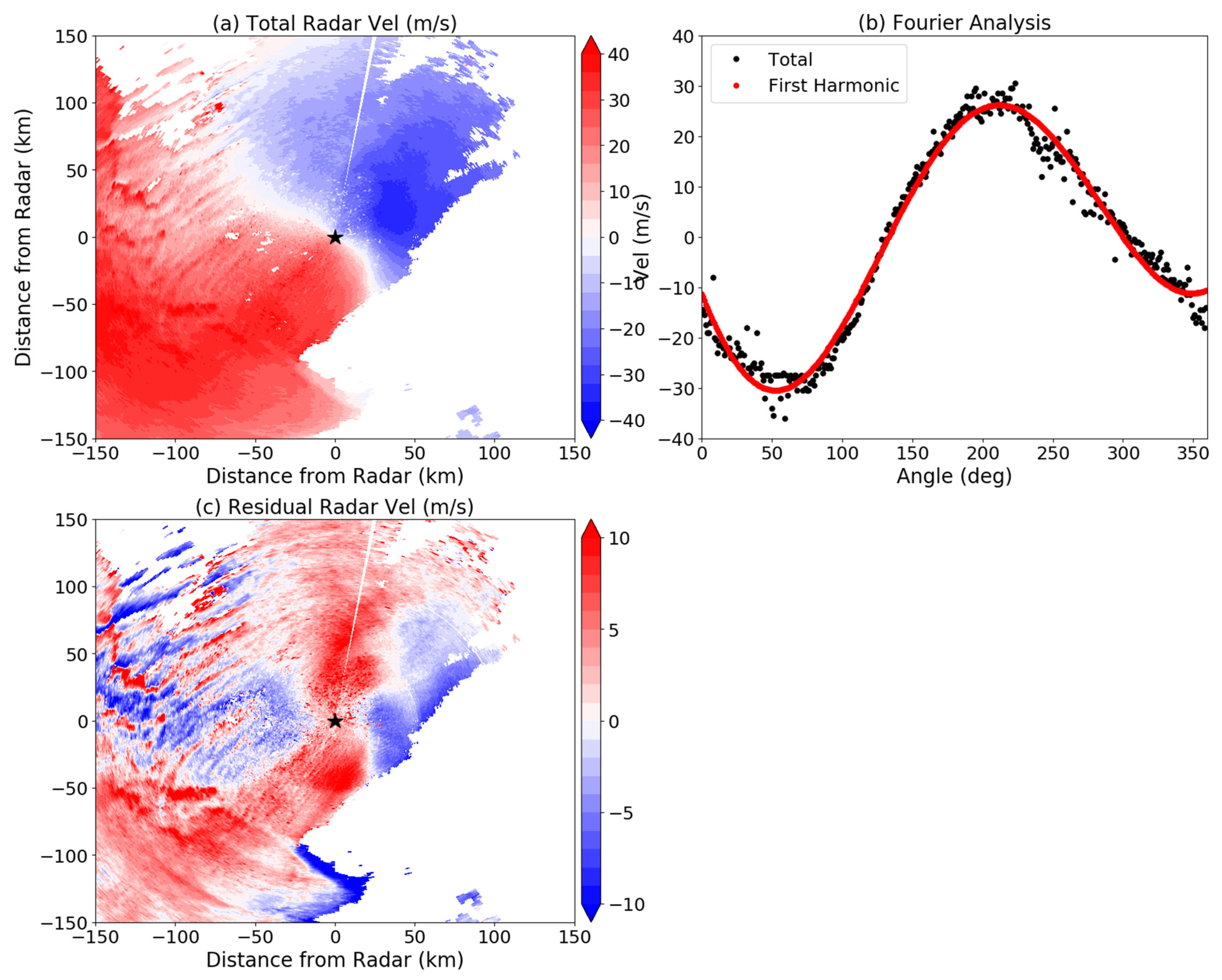
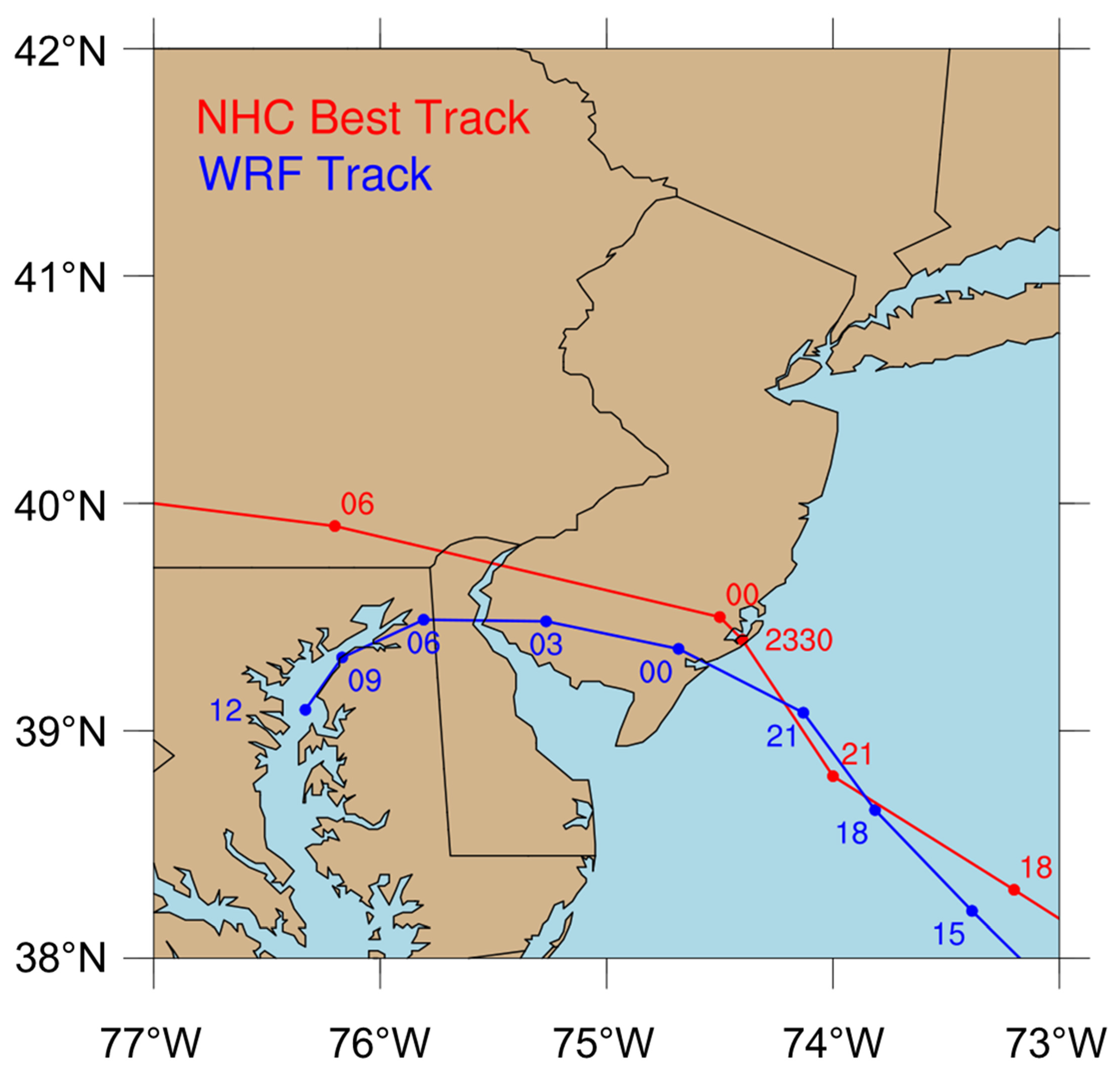

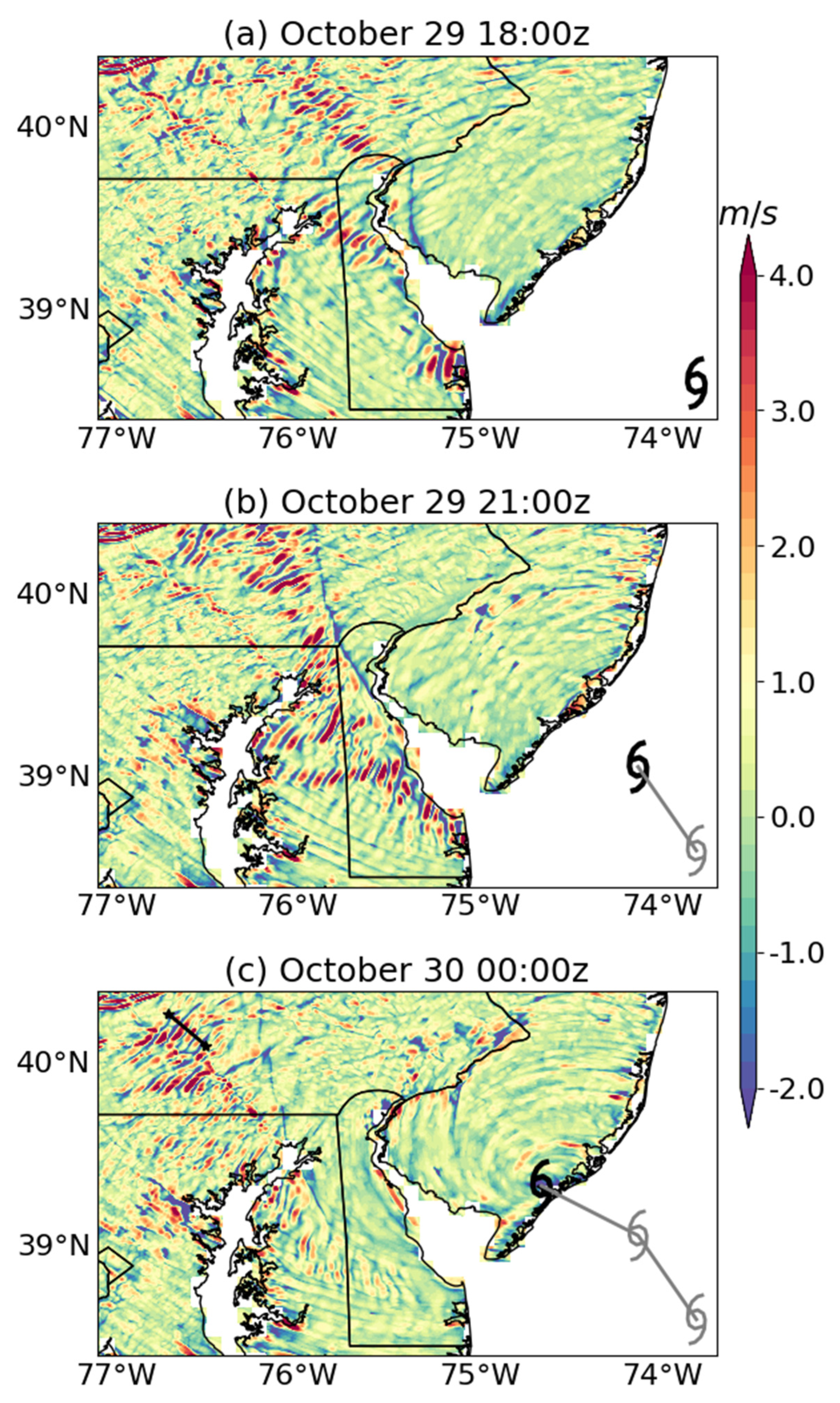

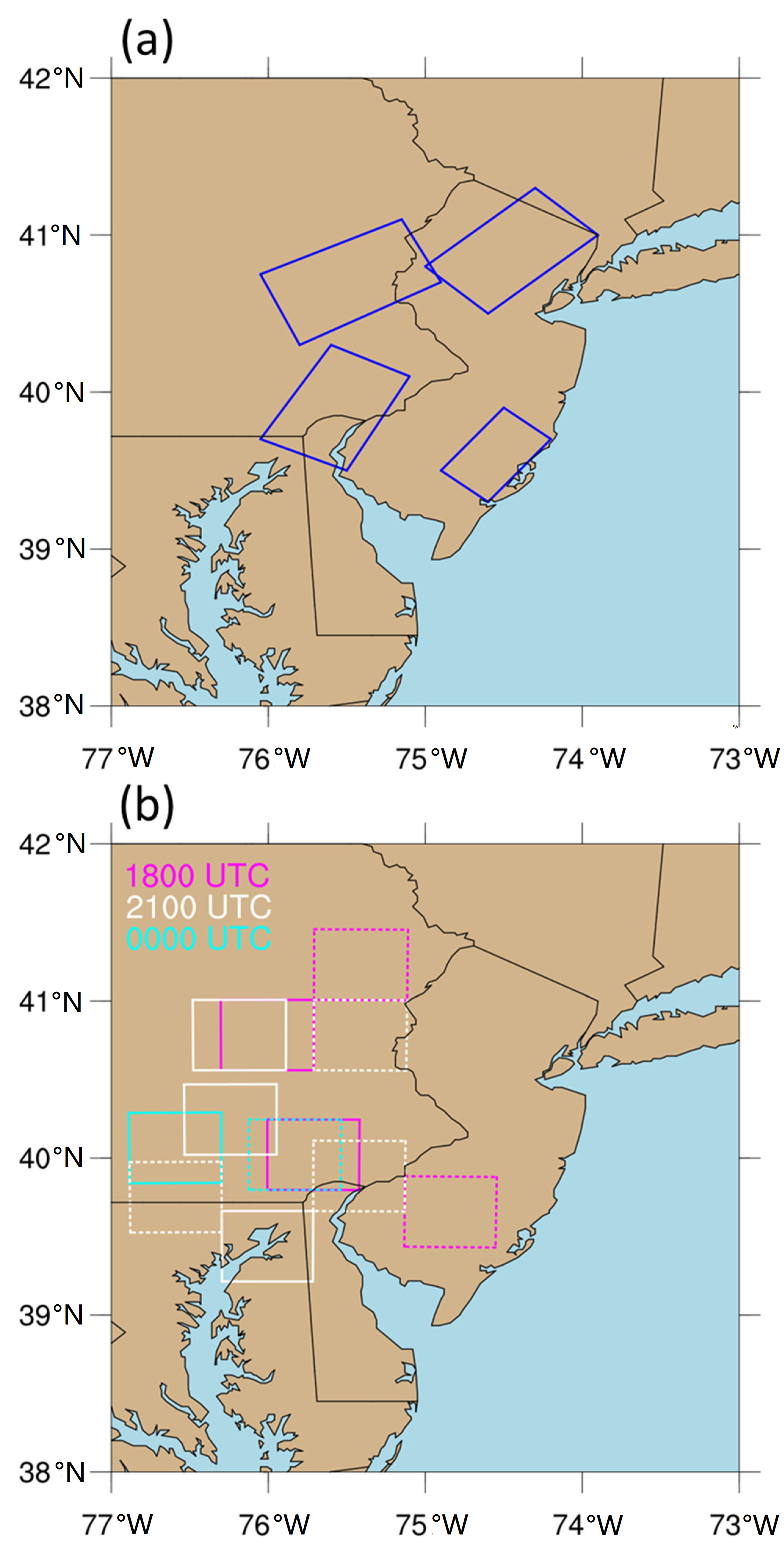
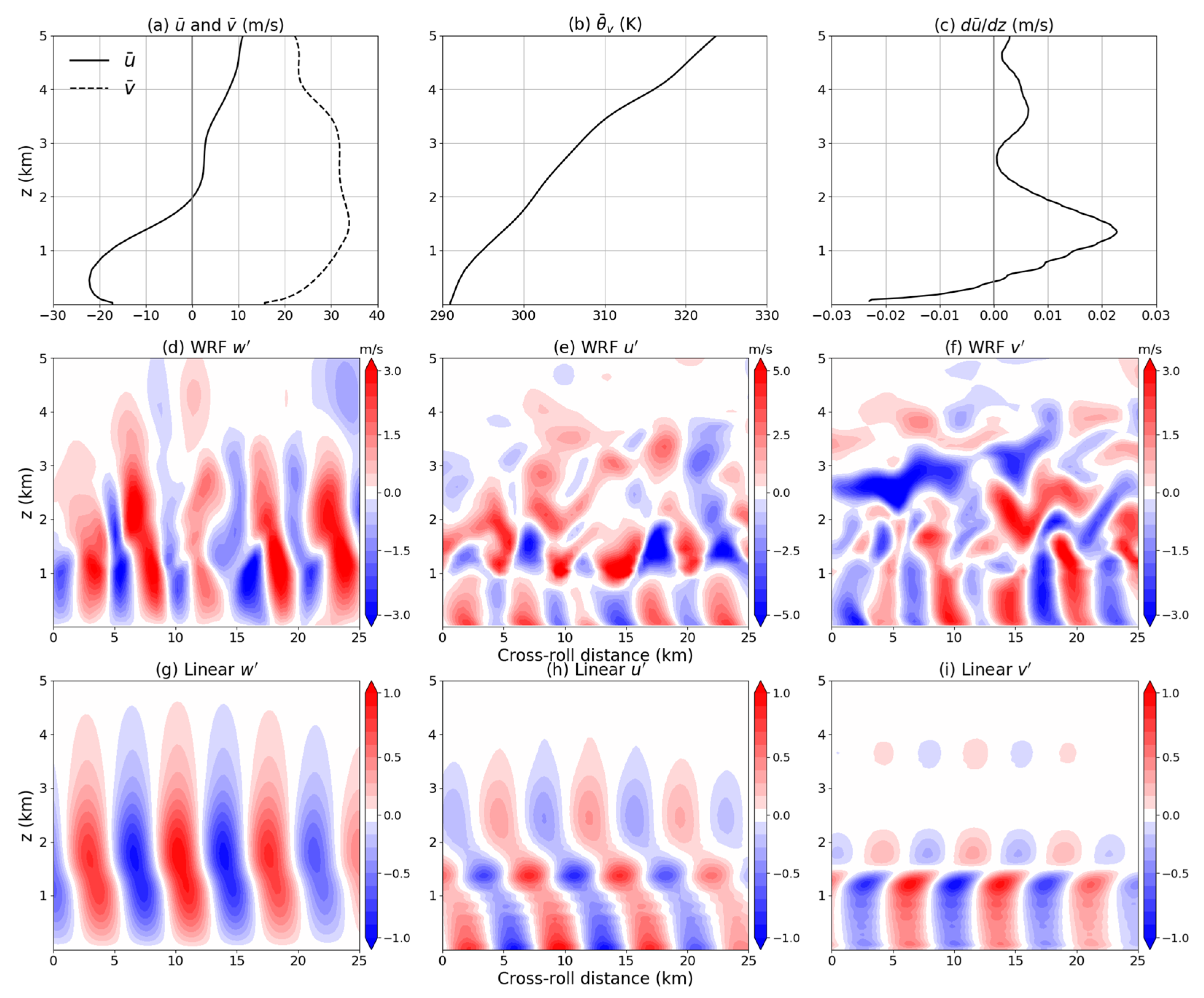

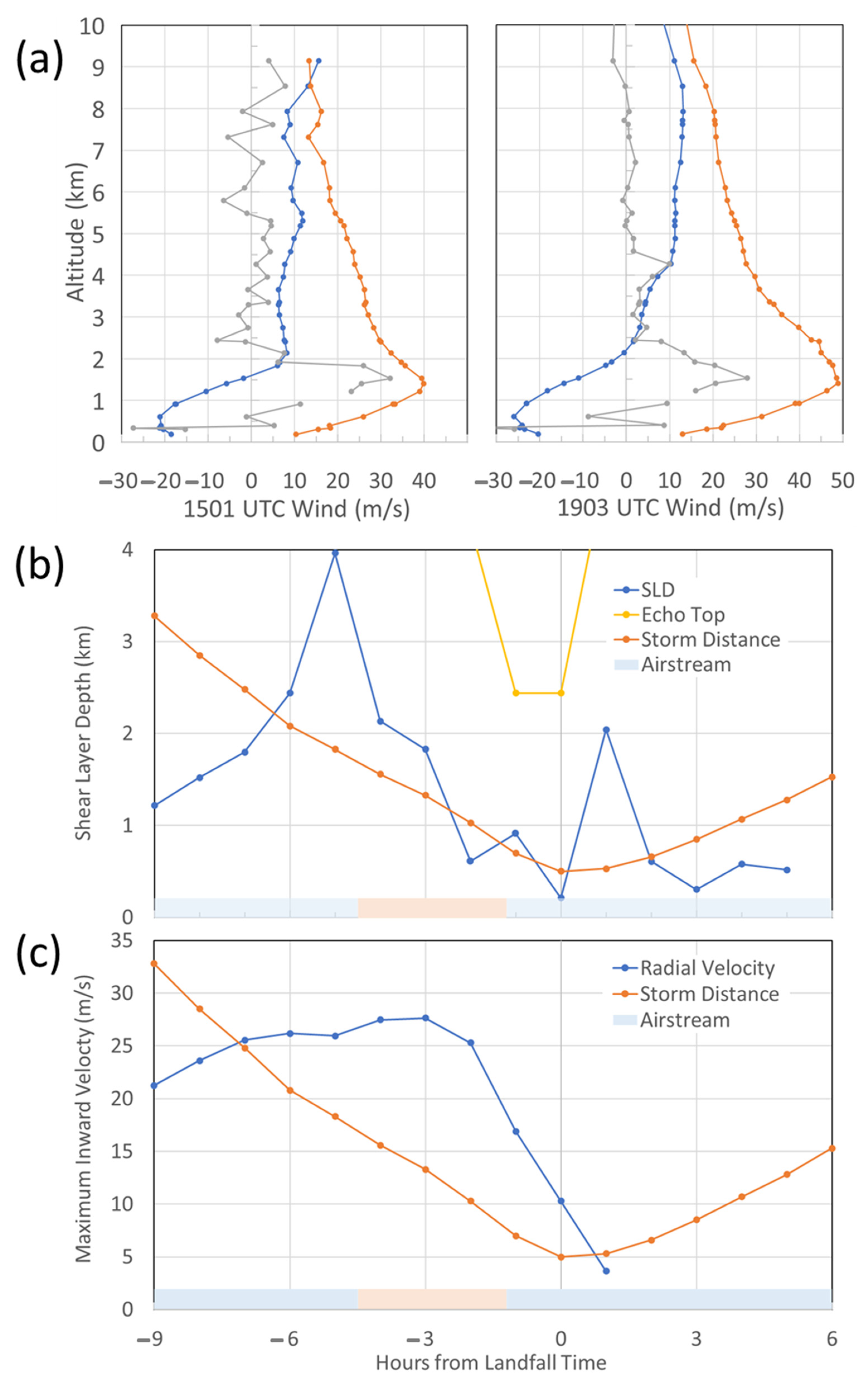
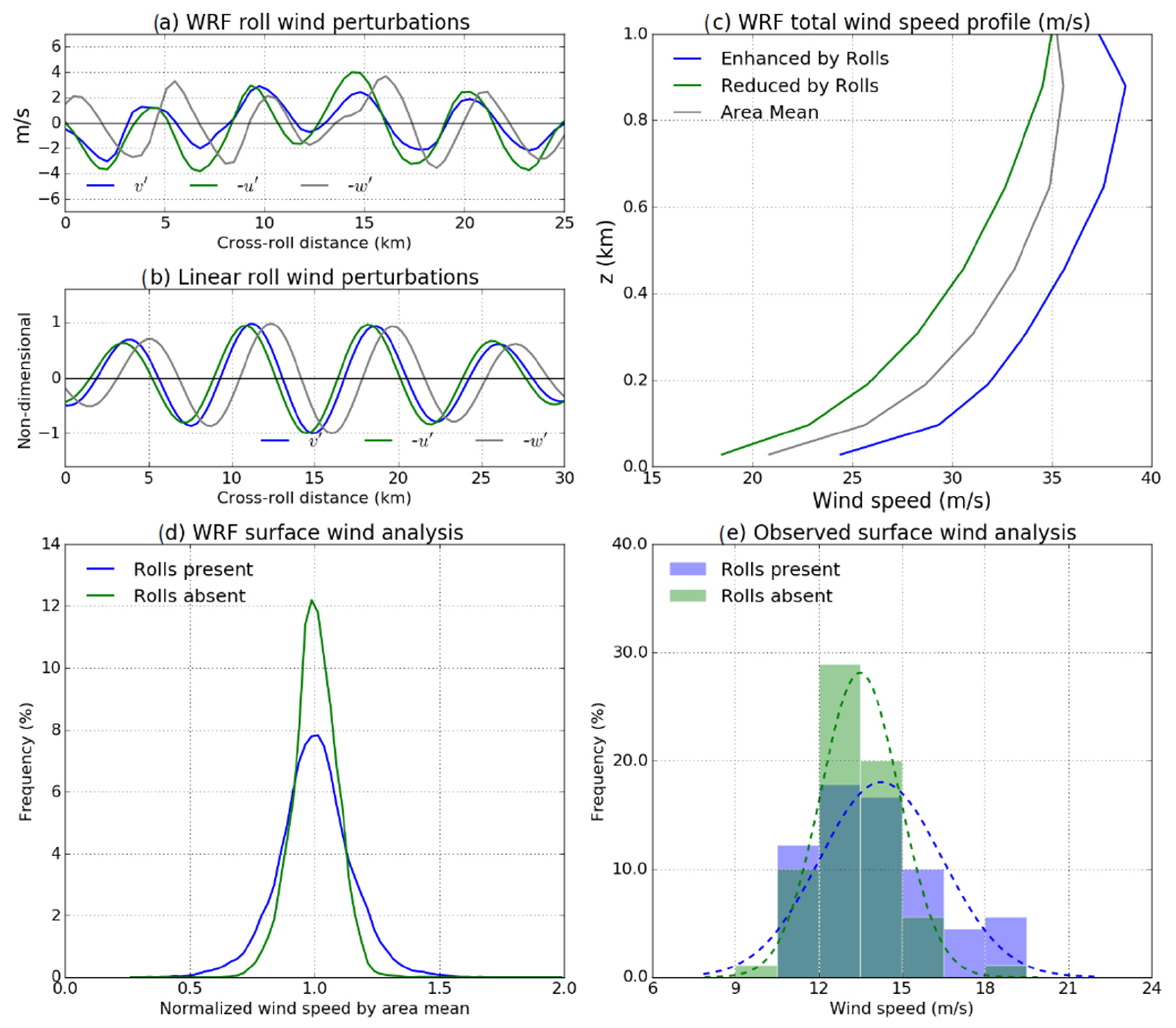
Publisher’s Note: MDPI stays neutral with regard to jurisdictional claims in published maps and institutional affiliations. |
© 2021 by the authors. Licensee MDPI, Basel, Switzerland. This article is an open access article distributed under the terms and conditions of the Creative Commons Attribution (CC BY) license (http://creativecommons.org/licenses/by/4.0/).
Share and Cite
Schiavone, J.A.; Gao, K.; Robinson, D.A.; Johnsen, P.J.; Gerbush, M.R. Large Roll Vortices Exhibited by Post-Tropical Cyclone Sandy during Landfall. Atmosphere 2021, 12, 259. https://doi.org/10.3390/atmos12020259
Schiavone JA, Gao K, Robinson DA, Johnsen PJ, Gerbush MR. Large Roll Vortices Exhibited by Post-Tropical Cyclone Sandy during Landfall. Atmosphere. 2021; 12(2):259. https://doi.org/10.3390/atmos12020259
Chicago/Turabian StyleSchiavone, James A., Kun Gao, David A. Robinson, Peter J. Johnsen, and Mathieu R. Gerbush. 2021. "Large Roll Vortices Exhibited by Post-Tropical Cyclone Sandy during Landfall" Atmosphere 12, no. 2: 259. https://doi.org/10.3390/atmos12020259
APA StyleSchiavone, J. A., Gao, K., Robinson, D. A., Johnsen, P. J., & Gerbush, M. R. (2021). Large Roll Vortices Exhibited by Post-Tropical Cyclone Sandy during Landfall. Atmosphere, 12(2), 259. https://doi.org/10.3390/atmos12020259






